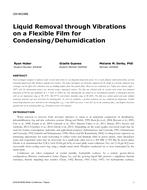Description
Heat exchangers designed to condense steam or water from moist air are frequently made from metal. As a result, filmwise condensation forms, and the increasing liquid water film thickness impedes heat transfer. This paper investigates an alternative approach for the design of a flexible, polymeric heat exchanger and the effects that vibrations have on shedding droplets from these plastic films. Moist air was condensed on a Teflon sheet (contact angle = 105°) and the condensation process was observed using a high-speed camera. The film was vibrated with an eccentric mass motor that produced frequencies of 90 Hz and amplitudes of plus or minus 1.1mm (plus or minus 0.043 in). The vibrating film was placed in an environmental chamber at atmospheric pressure with an air temperature range of 30-35°C (86-95°F) and relative humidity range of 50-66%. The film was actively cooled and water droplets nucleated, coalesced, and were shed from the vibrating film. At each test condition, a baseline stationary test was conducted for comparison. Smaller critical drop diameters were observed on the vibrating film [e.g., 1 mm (0.04 in) versus 5 mm (0.2 in) on the stationary film], and droplets shed more quickly than on the stationary film (e.g., 20 minutes versus 110 minutes).
Citation: 2018 Winter Conference, Chicago, IL, Conference Papers
Product Details
- Published:
- 2018
- Number of Pages:
- 8
- Units of Measure:
- Dual
- File Size:
- 1 file , 1.6 MB
- Product Code(s):
- D-CH-18-C009




